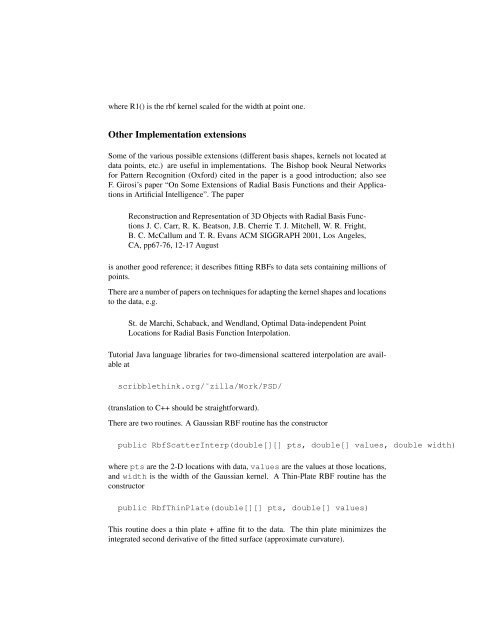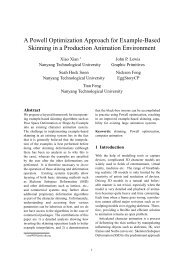Pose Space Deformation Notes - JP Lewis
Pose Space Deformation Notes - JP Lewis
Pose Space Deformation Notes - JP Lewis
You also want an ePaper? Increase the reach of your titles
YUMPU automatically turns print PDFs into web optimized ePapers that Google loves.
where R1() is the rbf kernel scaled for the width at point one.<br />
Other Implementation extensions<br />
Some of the various possible extensions (different basis shapes, kernels not located at<br />
data points, etc.) are useful in implementations. The Bishop book Neural Networks<br />
for Pattern Recognition (Oxford) cited in the paper is a good introduction; also see<br />
F. Girosi’s paper “On Some Extensions of Radial Basis Functions and their Applications<br />
in Artificial Intelligence”. The paper<br />
Reconstruction and Representation of 3D Objects with Radial Basis Functions<br />
J. C. Carr, R. K. Beatson, J.B. Cherrie T. J. Mitchell, W. R. Fright,<br />
B. C. McCallum and T. R. Evans ACM SIGGRAPH 2001, Los Angeles,<br />
CA, pp67-76, 12-17 August<br />
is another good reference; it describes fitting RBFs to data sets containing millions of<br />
points.<br />
There are a number of papers on techniques for adapting the kernel shapes and locations<br />
to the data, e.g.<br />
St. de Marchi, Schaback, and Wendland, Optimal Data-independent Point<br />
Locations for Radial Basis Function Interpolation.<br />
Tutorial Java language libraries for two-dimensional scattered interpolation are available<br />
at<br />
scribblethink.org/˜zilla/Work/PSD/<br />
(translation to C++ should be straightforward).<br />
There are two routines. A Gaussian RBF routine has the constructor<br />
public RbfScatterInterp(double[][] pts, double[] values, double width)<br />
where pts are the 2-D locations with data, values are the values at those locations,<br />
and width is the width of the Gaussian kernel. A Thin-Plate RBF routine has the<br />
constructor<br />
public RbfThinPlate(double[][] pts, double[] values)<br />
This routine does a thin plate + affine fit to the data. The thin plate minimizes the<br />
integrated second derivative of the fitted surface (approximate curvature).







